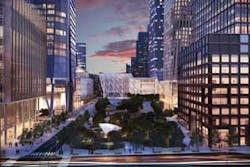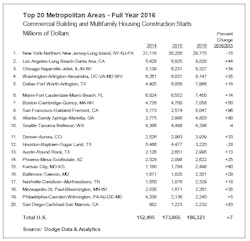Latest from Economic Indicators
EW's Latest Metro- and State-Level Sales Estimates
Sponsored
2016 Non-Residential Construction Rises in Top U.S. Metropolitan Areas
Most of the leading U.S. metropolitan areas for commercial and multi-family construction starts showed substantial gains in 2016 compared to the previous year, according to a recent press release from Dodge Data & Analytics. However, New York NY, the top metropolitan market by dollar amount, pulled back 15% to $29.8 billion following its 67% surge to $35.2 billion in 2015.
Outside of the New York metro, eight of the next nine metropolitan areas in the top 10 were able to register double-digit gains during 2016. At the U.S. level, commercial and multi-family construction starts in 2016 were reported at $186.3 billion, up 7% from 2015.
Rounding out the top five metropolitan areas in 2016, with their percent change from 2015, were: Los Angeles CA, $9.8 billion, up 44%; Chicago IL, $8.3 billion, up 34%; Washington DC, $8.1 billion, up 35%; and Dallas-Ft. Worth TX, $8.0 billion, up 16%. Metropolitan areas ranked 6 through 10 were – Miami FL, $7.5 billion, up 14%; Boston MA, $7.1 billion, up 50%; San Francisco CA, $5.0 billion, up 96%; Atlanta GA, $4.8 billion, up 60%; and Seattle WA, $4.3 billion, down 4%.
The commercial and multi-family total is comprised of office buildings, stores, hotels, warehouses, commercial garages, and multi-family housing. At the U.S. level, the 7% increase for the commercial and multi-family total in 2016 was the result of an 11% advance for commercial building and a 3% gain for multi-family housing. Compared to its 7% rise in 2015, commercial building at the U.S. level was able to pick up the pace in 2016, while multi-family housing witnessed substantially slower growth compared to its 22% jump in 2015.
A primary reason for the smaller 2016 increase for multi-family housing at the U.S. level was a downturn by multi-family construction starts in the New York NY metropolitan area, which retreated 28% following its exceptionally strong amount in 2015. Excluding the New York NY metropolitan area, multi-family housing for the nation in 2016 would be up 13%, about the same as the corresponding 14% increase in 2015.
“What stands out about 2016 is that growth for commercial and multi-family construction starts became broader geographically,” Robert Murray, chief economist for Dodge Data & Analytics, said in the press release. “Back in 2015, the New York NY metropolitan area led the upturn by soaring 67%, while the next 9 markets combined grew 8%. In 2016, the 15% downturn in the New York NY market was countered by a 33% hike for the next 9 markets.
"As a result, the New York NY share of the U.S. total for commercial and multi-family construction starts settled back from 20% in 2015 to 16% in 2016, which was still relatively high compared to the 13% share during the 2010-2014 period.”
“Both commercial building and multi-family housing have benefitted from a number of positive factors in recent years,” Murray continued. “These included declining vacancies, rising rents, low interest rates, and some easing of bank lending standards for commercial real estate loans. That supportive environment began to shift during 2016, with vacancies leveling off, interest rates edging up at year’s end, and bank lending standards for commercial real estate loans beginning to tighten, especially for multi-family projects.
"Yet, aside from multi-family housing, the levels of construction remain generally low given the hesitant nature of the upturn to date, meaning there’s yet to be any widespread signs of overbuilding that typically show up five years into an expansion. While market fundamentals may not be quite as supportive in 2017, it’s still expected that commercial building will be able to register moderate growth, led by offices and warehouses.
"As for multi-family housing, the geographically broader participation by metropolitan area that emerged during 2016 is expected to continue this year, which should help the national total stay close to the elevated activity reported during 2015 and 2016. Other factors that could affect commercial and multi-family construction starts in 2017 would be two items proposed by the Trump Administration – the reduction in business tax rates to spur investment and the easing of the Dodd-Frank regulations on the banking sector.”
Check out the table below for a quick look at Dodge's compilation of the largest construction projects in the U.S.'s five largest metropolitan areas.




